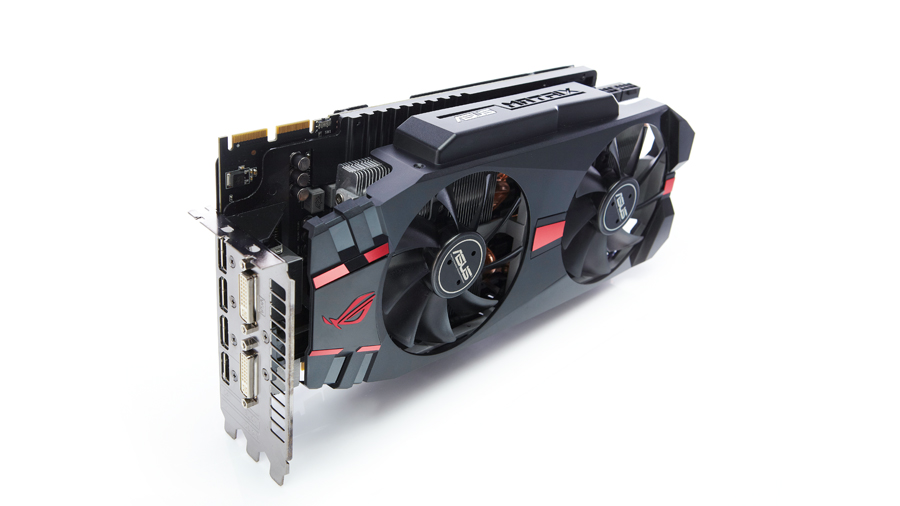TechRadar Verdict
Pros
- +
Good performance
- +
Solid build quality
- +
Good options
Cons
- -
Too expensive
- -
Not new GPU tech
Why you can trust TechRadar
Earlier this year, Nvidia launched a whole new family of GeForce GTX 700 series high-performance GPUs. Except none of them were actually new. They were either straight rebadging efforts or, at most, existing chips mildly tweaked. And then rebadged.
Now it seems AMD is at it, too. While there are a couple of new GPUs in this new range, in the form of the R9 290X and the R9 290, the other GPUs that have just been "released" are simply rebadged GPUs from the 7000 family. That includes the GPU at the heart of the R9 280X Matrix Platinum from Asus.
What we have here is AMD's Tahiti XTL GPU, which is simply a respin of the Tahiti GPU that can be found in the Radeon HD 7950 and 7970. To all intents and purposes the new R9 280X is identical to the outgoing Radeon HD 7970. That means 2,048 shaders, 128 textures, 32 ROPs, yada yada… only the clockspeed seems to be any different, which is officially defined as up to 1GHz.
Except not in the case of this Asus take on the "new" 280X. The Platinum Edition boards rock up at 1,100MHz, 10 per cent faster than the reference design. OK, that may not seem that dramatic, not by CPU overclocking standards. But this is a GPU, and in that context 10% is actually quite a bump.
Anyway, there's more than just a clockspeed boost to perve over here, like the monumental triple-slot cooling solution. Then there's the VGA Hotwire feature that allows direct overvolting of the GPU, and TweakIt buttons that allow said overvolting to be finessed with a poke of a finger. Clever stuff. There's even a safe mode switch that brings everything back to stable defaults. Oh, and Japanese black metallic capacitors all round.
At which point, this is all beginning to sound like a high-end motherboard review. And that's kind of how Asus is pitching its Matrix series of graphics cards: it's all about tweakability and the quality of the components.
The final feature of note involves video outputs. You get a pair of DVI ports and no fewer than four DisplayPort sockets. There's full 4K support, though - as you can read elsewhere - 4K panels demand massive GPU performance.
Sign up for breaking news, reviews, opinion, top tech deals, and more.
As good as the 280X chipset is, it's not brilliant. For the most part, there are no performance surprises. The Matrix Platinum kicks out the kind of numbers you'd expect from a Radeon HD 7970 GHz-and-a-bit edition. Which is what this board really is.
Benchmarks
A Radeon HD 7970 GHz by another name is what we suspected when AMD announced the Radeon R9 280X. And that's what it looks like by the benchmark numbers. We've got the 7970 GHz lined up against Asus's overclocked 280X running at 1.1GHz, along with an HIS 280X at 1.05GHz.
The results are mostly as you'd expect from overclocked 7970s, with the exception of Metro: Last Light, which seems to enjoy the new 280X. We'd guess that reflects tweaks to the 280X's drivers, as the hardware is the same. Figures in brackets are minimum framerates.
DirectX 11 tessellation performance
Heaven 4.0 (MIN): Average FPS: Higher is better
Asus Radeon R9 280X Matrix Platinum: (24) 54
AMD Radeon HD 7970 GHz: (23) 51
HIS Radeon R9 280X: (26) 53
DirectX 11 gaming performance
Metro: Last Light (MIN): Average FPS: Higher is better
Asus Radeon R9 280X Matrix Platinum: (33) 58
AMD Radeon HD 7970 GHz: (25) 51
HIS Radeon R9 280X: (32) 56
DirectX 11 gaming performance
Company of Heroes 2 (MIN): Average FPS: Higher is better
Asus Radeon R9 280X Matrix Platinum: (27) 48
AMD Radeon HD 7970 GHz: (28) 46
HIS Radeon R9 280X: (30) 46
Verdict
There's no shame in these figures, but new branding does generate expectations of something novel and on the chipset side there's nothing. That's not Asus' fault, of course.
But there's the problem: the one good thing that usually comes with this kind of rebrand is a price drop. In other words, the main appeal of the Radeon R9 280X will be to give you a 7970 GHz for less cash. But that's the opposite of what Asus is offering with this premium, overclocked board. This is just too costly.
Technology and cars. Increasingly the twain shall meet. Which is handy, because Jeremy (Twitter) is addicted to both. Long-time tech journalist, former editor of iCar magazine and incumbent car guru for T3 magazine, Jeremy reckons in-car technology is about to go thermonuclear. No, not exploding cars. That would be silly. And dangerous. But rather an explosive period of unprecedented innovation. Enjoy the ride.
